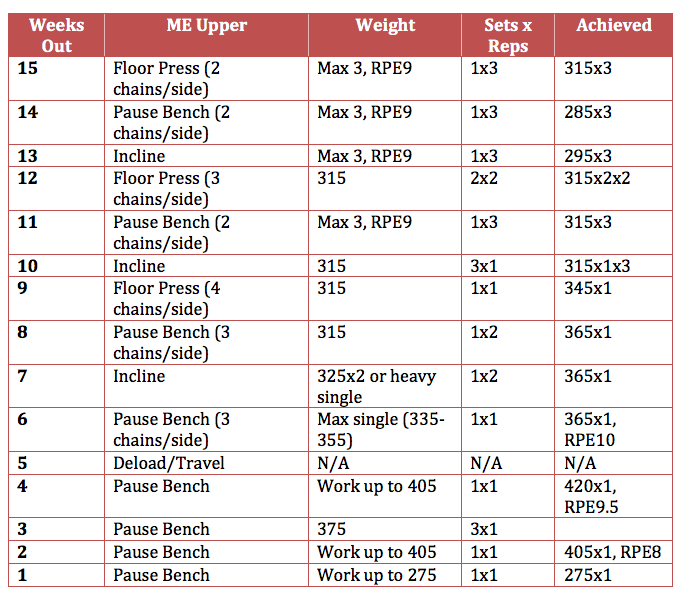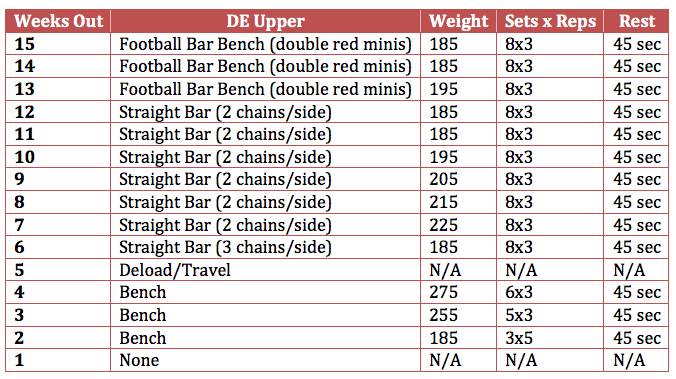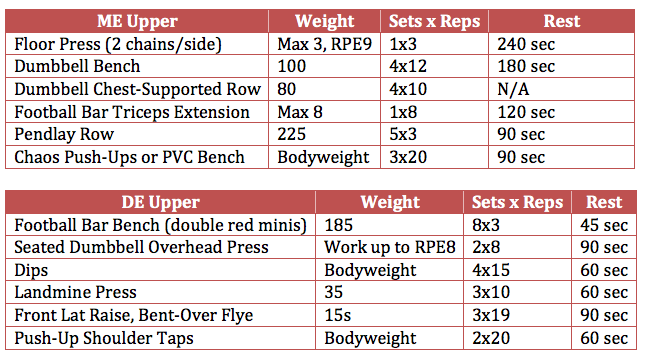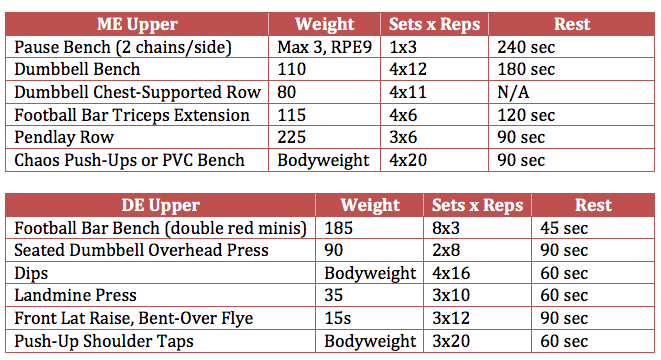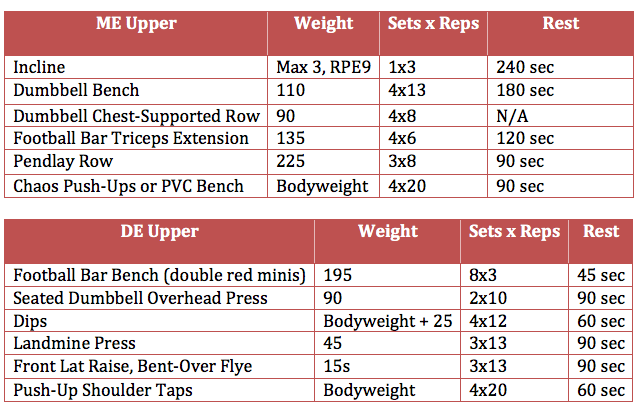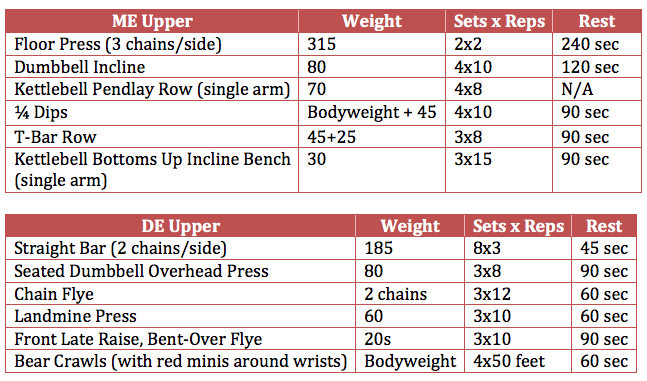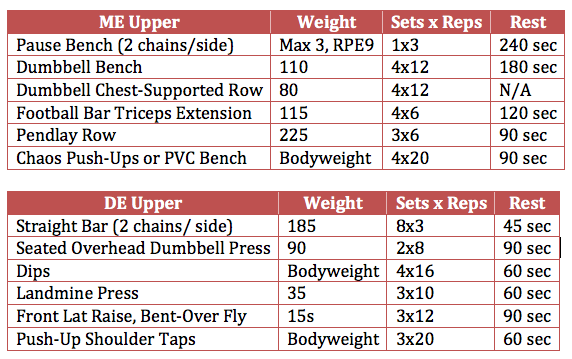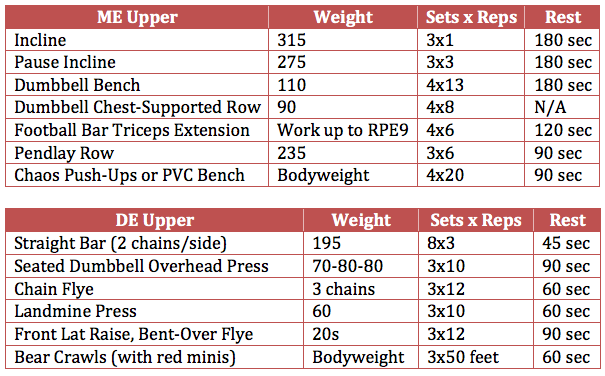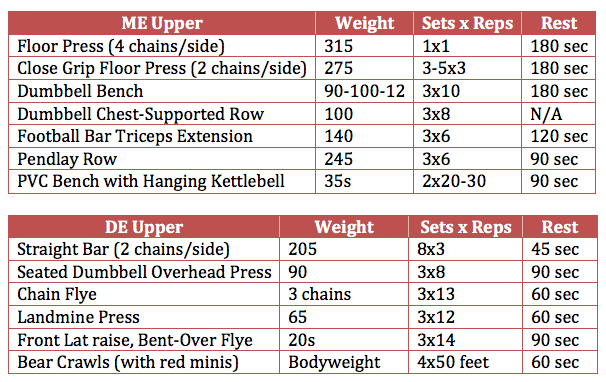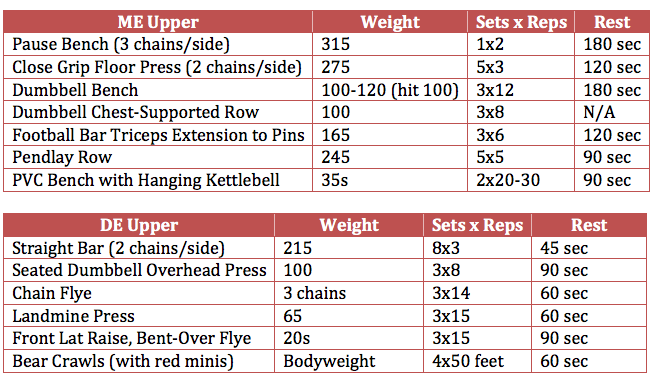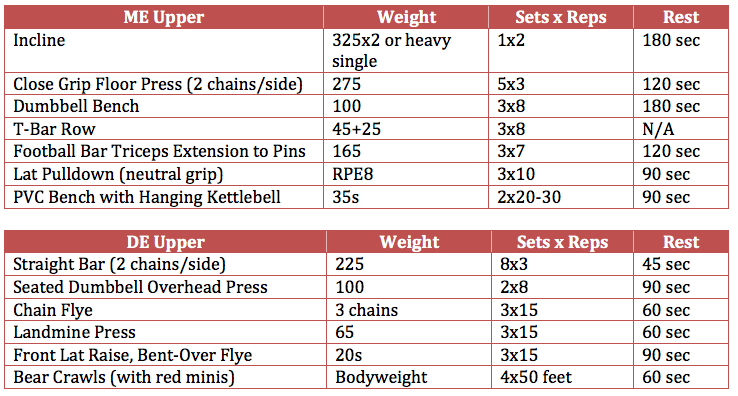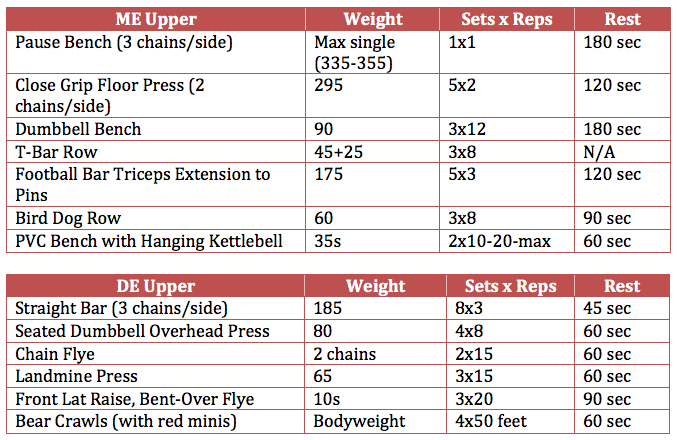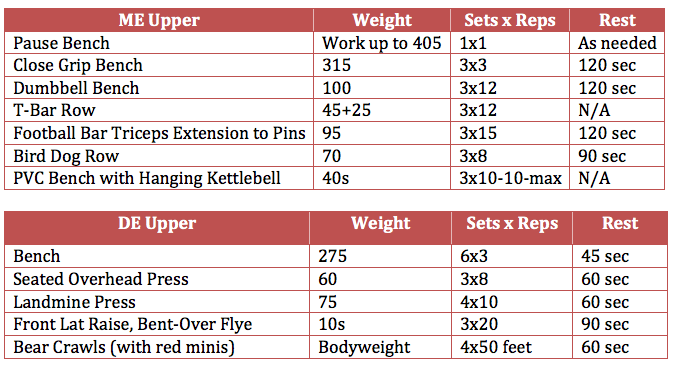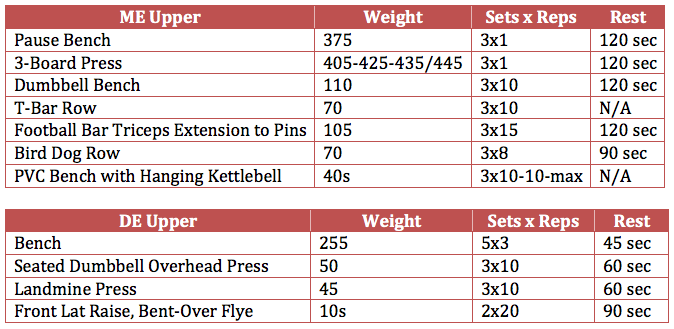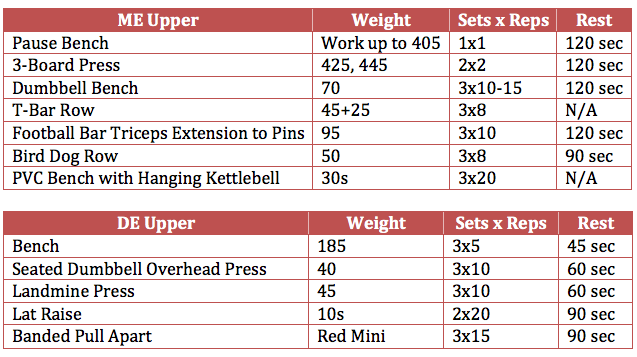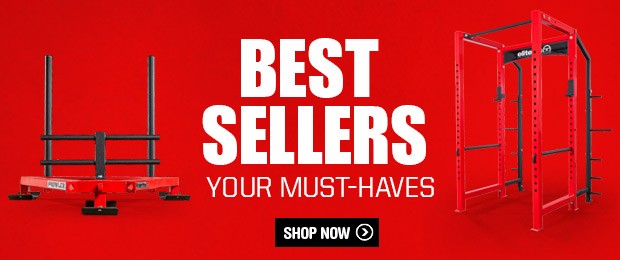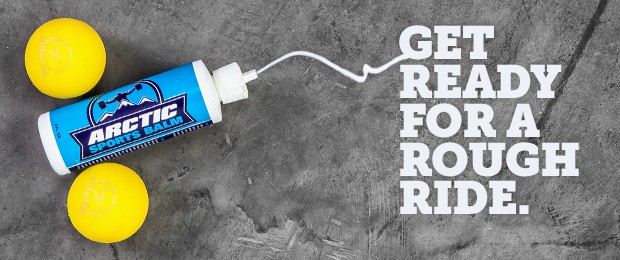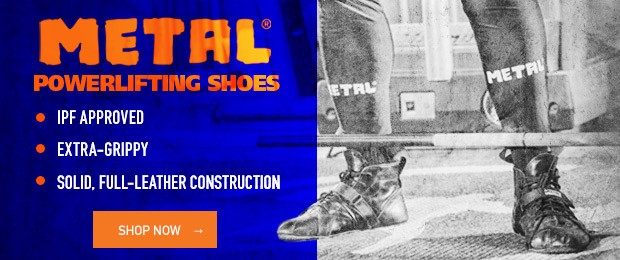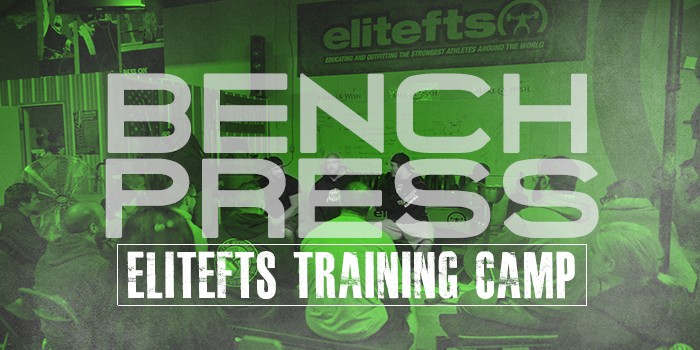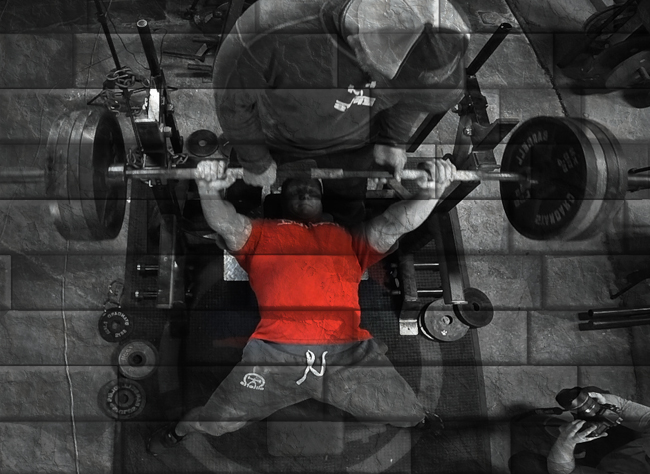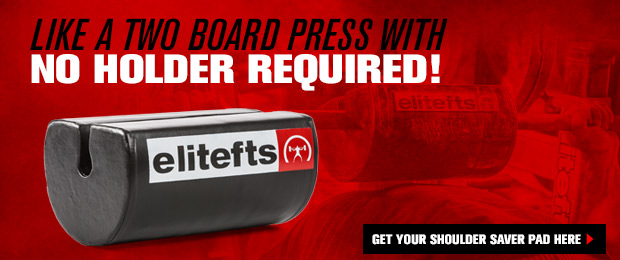Cody hit a 10-pound deadlift PR to secure a PR total at the Iron City Open with this deadlift cycle. It's one version of how I program a conjugate style of training for raw powerlifters.
I program it into the dynamic effort day. The first eight weeks of the program included box squats prior to deadlifts. We cut out traditional speed work four weeks out from the meet.
RECENT: Add 10 Pounds to Your Bench With This 15-Week Conjugate Cycle
Takeaways:
- Cody sucks at leaving me notes.
- His best deadlift before this was 640. He pulled 650 at this meet for a PR total after a bench PR.
- He pulled over 90 percent twice in those 12 weeks.
- The basics work pretty well.
- Similar to the dynamic effort upper days in my previous post with Cody, it took us some time to feel out the speed work together. Going into the next cycle, I'll be able to make this more effective for him.
Week 1
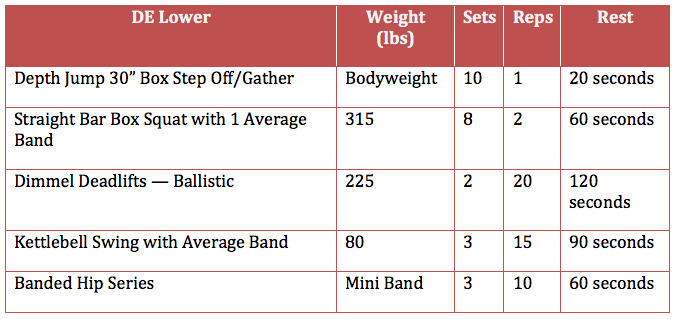
Week 2
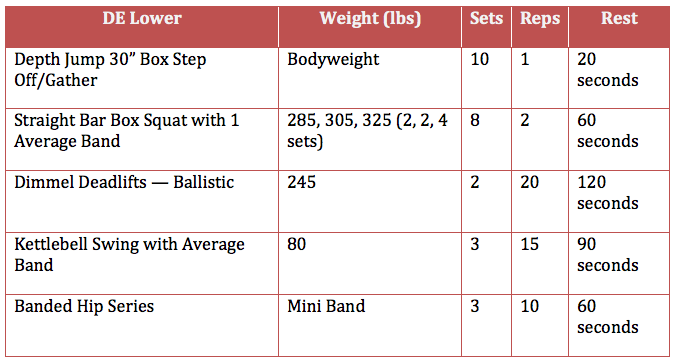
Week 3
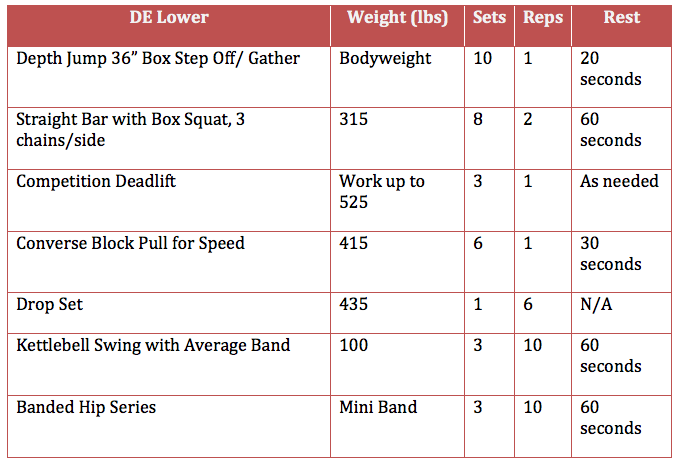
Week 4
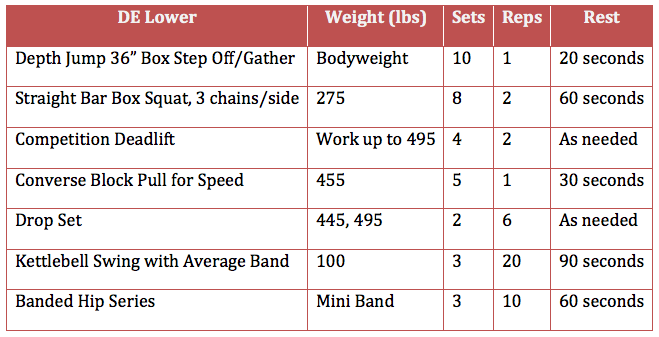
Week 5
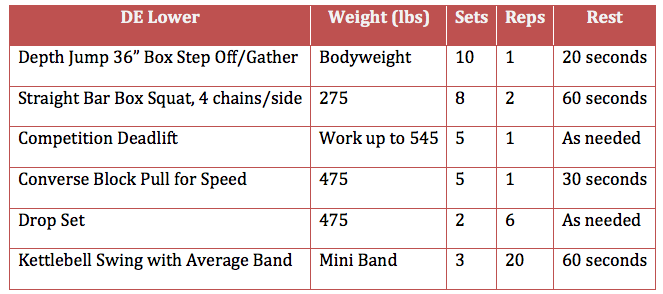
Week 6
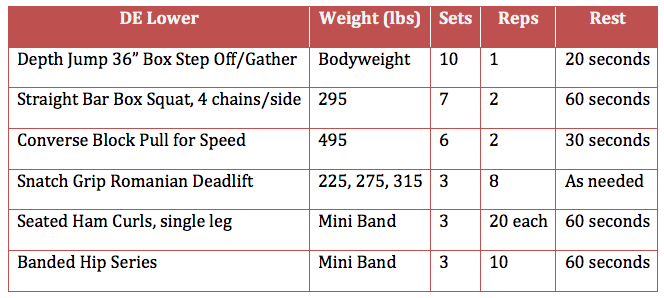
Week 7
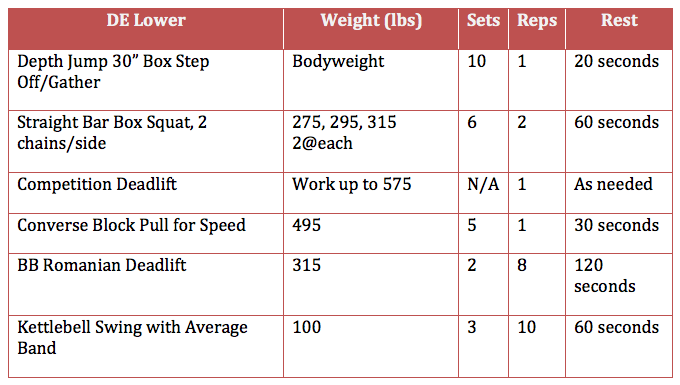
Week 8
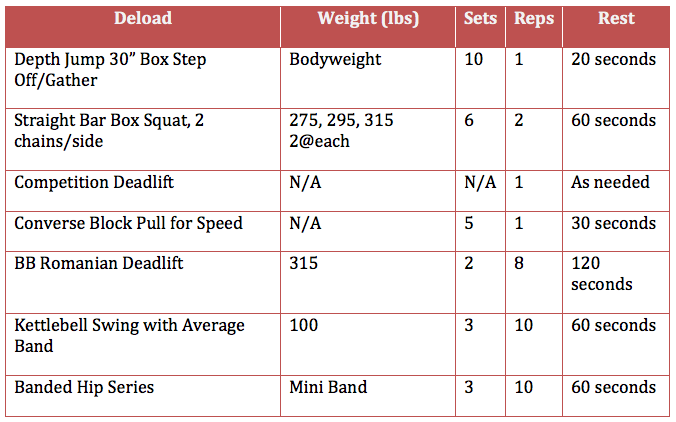
Week 9
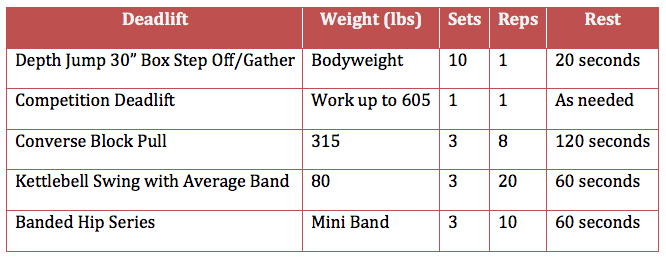
Week 10
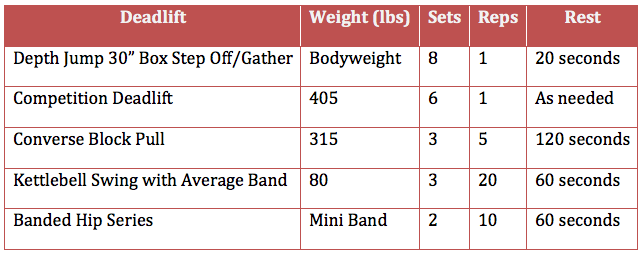
Week 11
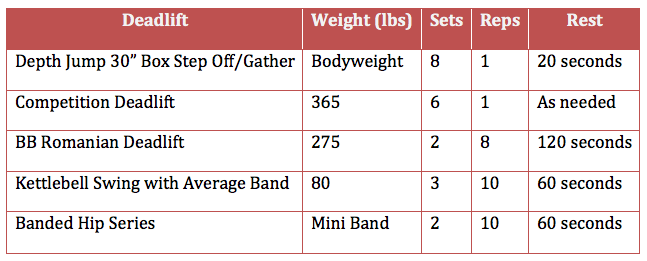
Week 12
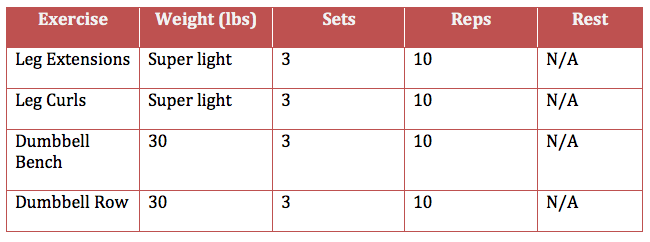
Remember Cody, my client I talked about in my last article about benching? He absolutely destroyed at the Iron City Open and got a 10-pound deadlift PR total. The secret to his success? It’s in this program… because it IS this program.
Cody is a member of Union Fitness who came to us from a powerlifting gym across town. Interestingly enough, he used to train with Dave Kirschen before moving to Pittsburgh. I have a ton of respect for Dave, although I don't know if I'd ever say that to his face. When Cody approached me for training, after his first year or so at UF, I was foaming at the mouth because...
RELATED: Union Fitness: Pittsburgh's Community Gym
- He wanted a Westside/Conjugate training approach.
- He had a bad experience with his previous gym, and I wanted to be the trusted coach and advisor that he was looking for.
- He had a lot of experience and plenty of potential. I prefer working with experienced lifters because it's easier for me in terms of communication, and sometimes they’re a tougher puzzle to crack. Not that I mind working with beginners, but I'd prefer they use resources like elitefts to learn from on their own before getting a coach because it's the trendy thing to do in powerlifting.
Cody's best bench was 424 going into this cycle, and at the Iron City Open last week, he hit a solid 434 (and even went on to pull 650 for a 10-pound PR). Without further ado, what you'll see here is the weekly max effort breakdown, the dynamic effort breakdown, and finally, at the bottom, all of the assistance work we used. I'll also leave my notes between each section. Enjoy!
Notes:
- We rotated floor press, incline, and pause bench.
- After getting a baseline in the first three weeks of max effort triples, we pushed the accommodating resistance up while moving to doubles and then singles.
- At six weeks out, we moved away from variations and stuck with pause bench, eventually removing accommodating resistance (specificity). I wanted him to go balls to the wall Week 6 knowing he was traveling the next week. Coming back for Week 4 I wanted him to hit a heavy single, but not a grinder. 405 moved really well, and 420 was good but slower, so that was the number for that day. For Weeks 4, 3, and 2, the main assistance movement was heavy board press, up to about 445 (what I had projected his max to be based off of training numbers).
- Keep in mind Cody is an experienced lifter, so he had the latitude on max effort days to push the intensity as he saw fit. He did a great job of managing that workload and keeping it within his ability level on any given training day. This is where feedback is invaluable — I need to know not only what it looked like, but how it felt and what was going on in his head during each session. Lifters tend to approach training sessions with expectations, which is what gets them into trouble, and Cody and I were able to work together to manage those expectations.
Notes:
- This is a fairly standard dynamic effort cycle, but it took us some feeling out in the first six weeks. It wasn't optimal. In a perfect world, I'd like to see consistently adding 10 pounds each week or more volume, but it worked.
- For our next training cycle, I'll have a better starting point for him and be able to manipulate this a little better.
- Lesson: As long as you're moving the weight with some speed, it's hard to totally fuck it up.
And then the whole kitchen sink...
15 Weeks Out
14 Weeks Out
13 Weeks Out
12 Weeks Out
11 Weeks Out
10 Weeks Out
9 Weeks Out
8 Weeks Out
7 Weeks Out
6 Weeks Out
5 Weeks Out: Deload/Travel
4 Weeks Out
3 Weeks Out
2 Weeks Out
Meet Week
When a Union Fitness client approached me for training, I was foaming at the mouth. He had experience in powerlifting and wanted a conjugate training approach. With this program, he added 10 pounds to his bench! You might as well give it a try.
On August 25, I made it to the mecca in Mountain View, California, for Boss of Bosses V. I had spoken to Dan a number of times about doing this meet, but health issues prevented that from happening the past two years. So I was beyond grateful that he still welcomed me to this fantastic event. I’ll get to the whole “how’d it go” portion eventually, but for the next few minutes, strap in and pay attention if you like a good drama.
The Fall
This was my first big meet after coming back from a bad bout with ulcerative colitis (UC). I was preparing for the Arnold in March 2017 when some “minor” health issues I was experiencing became something major. I lost 10 pounds the week of the meet—mind you, I wasn’t cutting weight. The frustrating part was that I was still stronger than I’ve ever been.
So, I showed up at the meet and met Dave. His advice was to shut it down for the day as he could tell by looking at me that my body was not ready for the platform. In the following five weeks, I lost 50 pounds (60 in six weeks). I was diagnosed with UC and, according to my doctor, I was dangerously close to losing my colon. This challenged my identity as a powerlifter.
After mixing and matching medications, I stabilized, or at least my bodyweight did. In September 2017, I did a single ply meet just to get back on the horse. I totaled 2,100 (200 pounds less than my best), but I really have no idea how I even did that. Sheer grit and determination, I suppose. I don’t pride myself on that as there’s a fine line between tough and stupid. But I did what I did.
Still Reeling
After that meet, I had another bad bout of a UC flare-up. I probably dropped another 15–20 pounds during that time. I started to realize that my symptoms were mostly based on my stress levels. Well, great bummer luck because as fun as powerlifting is, it’s interpreted purely as stress to the body. So, armed with that little nugget of information, I came up with a plan.
I visited the brilliant Eric Serrano and got a ton of advice along with some food allergy tests. I cut out anything that was even potentially inflammatory. What was I left with was beef/chicken/fish, potatoes, carrots, and cantaloupe. I ate these items at every meal for months and it helped. My body started to feel good, inflammation in my joints dropped dramatically, and my strength was coming back without pushing too hard.
I had hopes and wishes to do the U.S. Open and then Boss of Bosses. A couple months out from the U.S. Open, I realized I wasn’t ready. That was tough to admit, but I refocused. Boss of Bosses was the ticket, so I purchased flights and Yessie and I were going, no matter what…right?
Stress
Despite my focus on Boss of Bosses, the universe showed me who’s the real boss. Yessie and I were going through a lot of reflection, therapy, and rebuilding in our relationship. That was a big focus over the past year. She stuck by me while I was sick and through times of complete selfishness on my part. So, it was important for me to be there for her to rebuild the things that I had broken and I’ll circle back to this later.
In January or February 2018, my first dog, Lily, was diagnosed with osteosarcoma (bone cancer) and was given two months to live. She made it five months in good health and spirits up until the last two days. So, eight weeks out from the meet, I had to make the decision to put her down. It wasn’t easy, but it was a relief as I couldn’t watch her suffer anymore.
My second dog, Odi, didn’t take this very well. We gave him a few weeks, and he was so sad that it was impossible to ignore. He didn’t know what to do with himself. So, we started looking at adoption. We had four choices and they all got picked up immediately.
Fed up and worried about Odi, I called my breeder on a whim. He said, “Oh that’s funny I’m picking up puppies from a friend that I sired today.” I believe nothing is worth doing if not in excess—sometimes. So, I took two puppies and surprised Yessie when we picked them up on the way back from the Learn to Train at elitefts.
I also bought a minivan. In a short time, I’ll have about 450–500 pounds worth of dogs and I need transportation for them, so it was a minivan or a trailer. Minivans are the most comfortable thing on the road, so that’s what I’ll be rocking.
All the while, my meet preparation continued. In training, I squatted 815 and benched 545, both training PRs. Typically, I get a nice super compensation going into the meet and can add 3%–5% to those numbers. My deadlift technique was a big struggle during this time. I hit 750–775 a few times, but missed 800, which I had crushed going into the Arnold (815 actually).
So, I was feeling pretty good despite all of the outside factors swirling in my life.
The Real Stress
Eight days out from the meet, I woke up with a terrible stomachache. I saw blood in my stool and I was going to the bathroom every 30–45 minutes. It was a Friday so no doctors were around to help. I would have to get a stool sample tested (48 hours) before I could go on steroids to combat the symptoms if it was a flare-up. I was in trouble and lost about 8 pounds in the next 36 hours as my body held onto nothing and I couldn’t eat. My ailment ended up being a stomach bug that just hit me hard because of my condition.
I worked the next few days to get back to a normal bodyweight, but it was a struggle. I trained at 238–240 pounds most of the cycle, but was sitting at 235.
Two days out from the meet on the day of our flight, I woke up with cold sweats and puked in the toilet. Another bug. I couldn’t eat or drink. At that time, I wasn’t even sure if I could get on a plane, let alone if I should. What if I got really sick in California? What if I need to go to the hospital? The downward spiral started.
Making matters worse, I screwed up and booked a flight on Thursday instead of Wednesday, thinking the meet was on Sunday. I’m not one to make those mistakes, but I paid for it in this case.
At the airport, I kept some water down and actually ate a meal. We arrived at our gate and got hit with a two-hour delay. The smoke from the wildfires that were running through California reduced visibility to the point where the airlines had to reroute flights.
So instead of landing at 7:00 p.m. West Coast time, it was 9:00 p.m. After we landed and got our bags, the tram to the rental cars was down, so we got on the bus with all of the airport staff plus passengers. It was crowded.
We got our car, found a place to eat, and headed to Harry Selkow’s residence. I love Harry as he’s an amazing human being and has been a great mentor to me, except when he put me on an air mattress that night.
Recovery Attempt
Yessie and I woke up and headed to weigh-ins. I was a solid 231.8— again, not on purpose. I would have preferred to weigh my normal 238–240. We ate all day. She took care of me by scheduling an IV and a float session. So I went to bed rested but still light. I imagined that I had gotten back to about 233 pounds.
The Big Day
In the morning, we got there early and found Chad Aichs and Steve Goggins. Both have been a huge help to me in training over the years and during meet days. It was nice having their support along with Yessie.
I warmed up for squats and they felt okay. I was definitely feeling some nerves. Those feelings were familiar, but I didn’t have quite the control over them that I normally had. The moment felt bigger than me.
My psoas were extremely tight likely from travel. Learning RPR from JL has been extremely valuable, but I couldn’t get my psoas to release. So, everything in my squat felt unstable and that was evident on my opener.
I took 750 pounds really slowly, but I moved the lift okay and I was in the meet. I went to 800 (after 815 in training), but in all honesty, I didn’t have the confidence I needed for it based on how the first one felt. Why jump to 800? Because I wasn’t going to take three squats. I knew I was already gassed. It was 800 or bust. The unrack felt fine. I hit the hole and my hips were nowhere to be found. I didn’t even get a stretch reflex. The spotters did a great job and brought me to my feet.
I knew then and there that my vision for the day was shattered. Based on my training numbers, I should have hit about 2,100 minimum that day, assuming good health. Yessie was cool, calm, and collected, minus some tension she and I were dealing with, so I just sat down, shut up, and ate.
Bench warm-ups felt strong, but again I was gassed after my first attempt. I was lucky to hit 540 on my second after a 500 opener. It was the biggest bench in the 242s, so at least I wasn’t a complete bitch that day.
Deadlifts are the bane of this training cycle. My hips were shot after squats, so I pulled conventional. Yes, it’s cool that I can pull both. No, I’m not good enough at either one right now. They both need technique work because they are holding me back.
I opened with 700 and it moved about as well as I predicted. I really didn’t want to take another deadlift. What for? Well, I was at a 1,990 pounds total. So, suck it up, Buttercup, I took 744 and finished it. It was heavy.
There was a feeling of relief when I put the bar back down. I was physically and emotionally exhausted, yet I made a comeback by defying my body. I showed that I can still hang with the big dogs even when the odds are not in my favor. But there were still some doubts: Do I have what it takes? Will I get to where I want to be in this sport? Questions that have answers only in due time.
To circle back, Yessie and I are not together anymore. I won’t get into the details as this is neither the time nor the place. But I will say it was because I was dishonest and I’ll always regret that. No one deserves half-truths, especially those that are closest to you.
I’ve always struggled to be completely open and honest in relationships. I have plenty of insecurities and walls up that make half-truths easier. So, my challenge moving forward is to address those head on.
I don’t know how Yessie and I will work things out. We’re both passionate and stubborn with good days and bad days since this trip. I want to publicly thank her for her support while I was sick and during the times of distrust where I really didn’t deserve having her in my corner. She’s a cool human being and I want to see her succeed in everything that she does.
What’s Next?
My primary goal over the next three to six months is to get my bodyweight up to 250 pounds. This will give me a cushion going into a meet where my stress naturally rises and my bodyweight tends to drop dramatically.
I also need to overhaul my deadlift technique and continue to hammer the things that I’ve improved in my squat.
I had a conversation with Dave during the LTT UGSS. I always go to him with the big picture questions because he gets it. He’s been there. He’s seen it time and time again through countless lifters. I don’t know anyone better than him, so why pretend like I do?
I explained to Dave what I thought I needed to do after this meet. I typically reflect on the past training cycle during the last two to three weeks before a meet because everything is so fresh. You know what you did well, and if you’re honest with yourself, you know what you could have done better.
Something along the lines of me saying, “I need to gain weight and get my explosiveness back.”
D: “What’s your endgame?”
C: “I think I can total 2,300 pounds and leave the sport on my own terms.” What I meant by that was I know what I CAN do, but will that be enough for me, or my ego? We’ve all seen those guys who are holding onto the dream, which is fine, but it’s not for me.
D: “So how long do you think you have left in the sport?”
C: “Conservatively, five years. Maybe more.” I’m 30 and have been lifting since I was 14 or 15 years old.
D: “So, what do you need to do NOW, to get there in five years?”
Lightbulb. End of scene. Say no more. #ciffhanger
I was beyond grateful that Dan Green still welcomed me to compete at Boss of Bosses V (a fantastic event) this year. Strap in and pay attention if you like a good drama.
“You know a workman by the chips they leave. It’s true. To judge your progress properly, just take a look at the floor.”
Young lifters, allow me to stand on my soapbox for a moment. I have been training in some capacity for the majority of my life. I turn 30 in December and I competed in my first powerlifting meet at 14. In 15 years of training, I can say with certainty that I haven’t spent longer than two months without lifting (outside of this recent illness, which for all intents and purposes we’ll call a fluke). So, what I’m getting at is that I’ve learned some things on lifting and longevity. In the same breath, I still have a shit-ton to learn. And I know I’m not qualified to speak on certain topics. However, when it comes to mindset and expectations, I think I’m well versed. So let me introduce you to a young gentleman from my gym.
We have a young buck that started training at Union Fitness a few months back. He was insistent upon aggressive linear periodization and how “easy” it would be to get strong. I was immediately worn out by his unbridled enthusiasm because I’m an old grumpy fuck at heart. Either way, he wanted to get stronger so I gave him 5/3/1 and outlined his assistance work. He followed it, making his own tweaks along the way, basically going for a max five, max three, and max single each week. As week four approached, he let me know he didn’t need a deload. I also informed him he no longer needed my assistance. I don’t have the patience to convince someone they need guidance.
WATCH: The Type of Training Programs I Have Used
I wrote him off for the next month. In all of our previous conversations, everything he talked about involved maxing out or being as strong as so-and-so on Instagram. The problem was, he didn’t have any chips on the floor. He wasn’t putting in the work to create any value (or strength in this case). I told him I wouldn't help him unless he was going to do EXACTLY as I told him. So when the time came, meaning I was in a good mood and he stopped bugging me incessantly, we started this relationship over. I gave him some very simple instructions: main movement at x percent for five sets of five (CAT style training), and then the main assistance work for each day. I told him if he followed that for four weeks he could come train with us. And to his credit, he did.
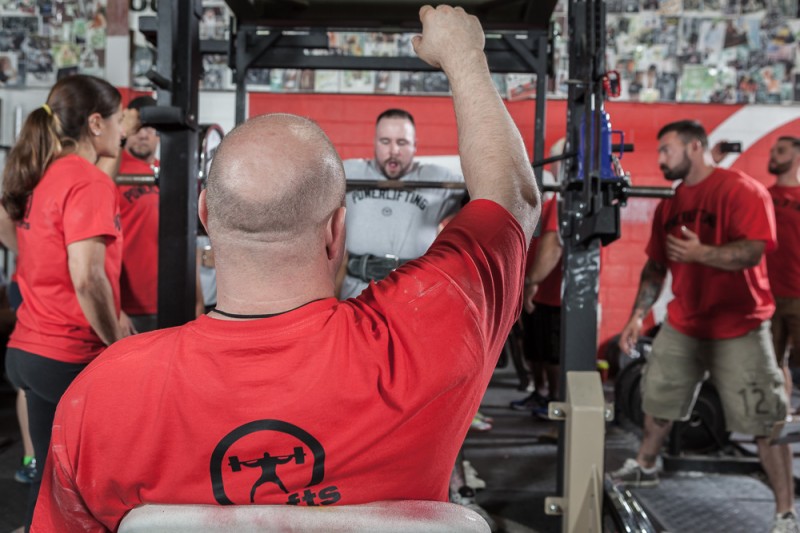
So week one of him training with us, he pulled 405 for two sets of five from a deficit. Great. Week two rolled around and he only managed 405 for four on his first set. He was obviously just fatigued, but it was exactly what I wanted him to do: fail in a scenario where he felt like he shouldn’t. In his mind, progress is linear. In his mind, every week he should be able to know exactly where his strength levels are. The realization started to set in for him. We can’t just add more weight to the bar every week and expect to get better.
Here’s the takeaway. It seems like every couple weeks I come across the casual statement, “I just want to test to see where I’m at,” coming from social media, online clients, or gym members. Now, if it’s a point in your program where you need to test—maybe the beginning or end of a training cycle—that makes sense to me. But when it’s the same guy every other week just checking to see where he’s at, I can tell you where he’s at: the same place as last time.
"You know a workman by the chips they leave."
We’ve all heard "back to the grind", but do you know where the saying comes from? How about “nose to the grindstone”? There are arguments over the origin due to some translation issues, but all we need here are the basics. A craftsman using a grinding wheel had to have his head in his work for safety reasons, but also for productivity. If he picked his head up every couple minutes to admire his work, he wouldn’t get anything done. It's the same for a lifter testing every few weeks to admire their work: it will leave them without much to admire.
Young lifters, listen up. Have some faith in your program and your ability. Pick a tried and true program and follow it for six months at a minimum. Have faith that you can get stronger, and it’s not the perfect program working magic on your muscles. (And it’s not those fucking supplements either.)
MORE: The Gift of Perspective: Things to Know as a New Powerlifter
Your progress is on the floor. Progress, for the young lifter, is doing the work daily. Putting in the time both inside and outside of the gym. Eating right. Getting to bed on time. Waking up and attacking the day. Learning at every opportunity.
The legends that came before you understood this. They didn’t get there by testing. They didn’t check to see where they were. They set their goals and put their nose to the grind without looking up until they got to the platform. The platform was their payoff. Every lifter has an ego. We lift to be better than we were yesterday. But that only happens when you’ve paid your dues, day in and day out, for months on end.
Let me introduce you to a young gentleman from my gym. Like a lot of inexperienced lifters, he didn’t understand what it really means to keep your nose to the grindstone.
2017 was a hell of a year. I’m sure some of you are tired of reading this by now, but for my own sanity, I’ll briefly recap it all. Sometimes looking in the rearview mirror provides a fresh perspective. In my humble opinion, I haven’t done shit in powerlifting...yet. That’s why I have to thank Dave, along with my elitefts family, from the bottom of my heart for being there for me. I can’t tell you how much I’ve learned from them in the last few years aside from "a lot."
In March I was on top of the world, ready for a huge total at the Arnold. I completed my weight cut, and then kept dropping weight. Normally sub-220 pounds would be a stretch for me. At weigh-ins, I was 214 and on meet day I was about 215, even after trying to rehydrate and eat. Obviously recognizing this was a problem, I backed out of the meet and was subsequently diagnosed with ulcerative colitis. Over the next eight weeks, I lost 60 pounds. It strained my relationship with Yessie, among other things that I was selfish about regarding our relationship. But she proved to be my rock. She has taught me to love myself and truly embodies unconditional love. For that, I’ll forever be gratefully indebted to her. I think we’ll get married, but she may have other ideas. Either way, we’ve both come to realize that’s life. And we promised to always be there for each other, no matter what.
WATCH: Anterior Pelvic Tilt Compilation Series — Dani Overcash and Casey Williams
After I got some relief from my gastrointestinal condition, I tried to get back to normal. I had lost so much blood that I was severely anemic and required a blood transfusion. I couldn’t stand up without getting dizzy. I couldn’t stand longer than a few minutes because I was so tired. I couldn’t go up or down stairs without losing my breath. It was humbling, to say the least. After my blood counts showed some signs of improvement, I decided to train.
I was lighter, sitting around 220. On day one I decided to squat, bench, and deadlift 135 pounds for three sets of 10 each. I was so weak and anemic that I was cramping and could feel myself getting sore while I was lifting. It made me laugh, in a way. Day two, a few days later, was squat, bench, and deadlift three sets of eight at 185 pounds. Then day three was three sets of six at 225, day four was 185 for three sets of ten, and so on. After a couple months of this, I got back to 405 on all three lifts and decided to put briefs on, which led to my decision to compete in September at Old School Iron.
Squat Rehab, May 2017 — 275 Pounds, 3x6:
Training went about as well as I could have expected. There were good days and bad days. I tried some multi-ply gear but it was too much for my strength levels at the time. But single-ply felt really natural and supportive, so it was an easy decision. In training I ended up squatting 800, benching 620, and deadlifting an easy 765 — about four months after being 180 pounds.
The meet didn’t translate so well. 800 pounds threw me around like a rag doll. A 600-pound bench was all I could manage with a bum knee, and a 700-pound pull was all I had in me at the end of a long day. To put it in perspective, I hit a 2300-pound total in single-ply in August 2016. Regardless, I was proud and that’s all I’ll say about that.
Challenges
I have some challenges ahead of me in order to get back to the platform and hit some big raw numbers.
- Physically: I need to get my diet dialed in so I’m not having digestive issues that interrupt training, or more importantly recovery. I need to keep up with recovery modalities like the X-Wife, deep tissue massages, etc.
- Mentally: I know I’ll have bad days where it feels like I’ll never get back to where I was before. I just have to have some faith that the only thing I can control is sticking to the plan and taking it one day at a time.
- Emotionally: To be your best in powerlifting, at any level, will force you through a wide range of emotions, so I don’t see a whole lot changing here, other than that when I get to the top, it will feel that much sweeter.
I typically consult Dave about my meet plans. I think I do a pretty good job of objectively analyzing where I’m at and where I can get over the course of the year. So Dave and I agreed that another single-ply meet in December would help me in the long run for a string of raw meets in 2018. During that time I’ll also be trying to put some mass back on. I’m back to about 235 pounds, but I can see in pictures that my back is smaller than it was before. That’s an obvious fix that I need to make to be at my best. From there, I plan to compete at the US Open at 242, weighing about as much as I can — if that means a small cut, good! Then I’d like to compete at Boss of Bosses in what I assume would be August. And finally, maybe single-ply again at the Olympia against Mr. Marshall Johnson.
Goals
- December — Total 2300 in single-ply again
- May 2018 — Bodyweight 250 pounds
- May 2018 — US Open Top Secret Total
- August 2018 — Top Secret Total
- Olympia 2018 — One pound over Marshall
Here's a vlog covering some of the same information, cut short with a Yessie Martinez phone call:
Single-ply 2300 total for reference (August 2016):
Pre-Arnold 800-pound raw squat (February 2017):
September 2017 Meet Lifts
Squat — 700 Pounds
Squat — 750 Pounds
Squat — 800 Pounds
Bench — 600 Pounds
Bench — 650 Pounds
Deadlift — 700 Pounds
All Lifts
At the beginning of this year I lost 60 pounds in less than eight weeks. I couldn’t stand longer than a few minutes because I was so tired. I couldn’t go up or down stairs without losing my breath. It was humbling, to say the least.
In this series compilation, Dani Overcash and Casey Williams walk you through the 90-90 Hip Lift, creating an anchor point, glute retraining, and shifting the pelvis back to neutral. Check out the entire physical therapy playlist on Youtube, too. Enjoy!
In lifting as in life, there are trials and tribulations. I think the majority of our readers can relate to the idea that there is no growth inside of your comfort zone. It’s why we get under weights that we’ve never squatted before and tear callouses trying to pull weights we’ve never pulled before.
The last two years of my life have been the most uncomfortable by far of my 28 years. But they’ve also been the most rewarding. I’ve gone through troubles surrounding relationships, my career, powerlifting, and most recently my health. I can say with certainty that I’m not the same person I was two years ago. And I can also say with certainty that I’m happy with who I’ve become. That’s an empowering statement when you can say it and feel it and mean it, Tony Robbins style.
The editors asked me to write this intro, and in all honesty, I didn’t know what direction to take it. So when in doubt, go with your gut and be as transparent as possible. This is one piece of the puzzle that has made me a better person. I put my ego aside and overcame some physical dysfunction to step back on the platform stronger and smarter. It took balls to step away from training and it took grit to stick to the plan even when I wasn’t seeing results.
I couldn’t have done it without Dani, Dave, Yessica, Marshall, Goggins, Bob, my training partners, and many others. But that’s what life is about — being resourceful when you get knocked on your ass. So take heed readers: life always wins. Your body is a rental and you have to turn it back in at the end of the ride.
So during your trip live life unapologetically, learn as much as possible, and pass on that knowledge to everyone who is receptive to it. Here is my first powerlifing setback and how Team elitefts fixed me — and how my struggles can help you.
Identifying and Resolving Hip Issues While Squatting
The 90-90 Hip Lift
Creating an Anchor Point
Glute Retraining
Shifting the Pelvis Back to Neutral
Bringing It All Together
WATCH: Table Talk Compilation Series — Justin Harris
In these six videos, Dani identifies and helps resolve Casey’s hip issues while squatting. How can Casey’s powerlifting setback help you?
To understand where you are and where you’re going, you have to realize where you’ve been. If you follow my logs then you already know. If you don’t, here’s the short of it.
I was on top. Or at least on my way to the top. I hit 2088 at RUM8 weighing 238 on a full stomach — light for the 242 class when the 220’s in the same meet were 240-260. I lined myself up for a meet four months later, and another four months after that with the 220 and 242 world record in my sights. I was training hard and usually pretty conservative. I pulled/tore my left adductor, left hamstring, and left glute all within six months of one another, the hamstring being the worst of it.
I was pissed. I was depressed. I was dumbfounded. I don’t think I ever pulled a hamstring or anything for that matter during college football. Always banged up with the usual wear and tear, but this was all new to me. I’ve dealt with adversity and injury — sprained AC joint, torn MCL, and multiple moments of, "oh i just got my bell rung." (This whole concussion deal didn't come until after my playing days).
During this time period my lifts were stagnant at best. I tried some new things. I tried some old things. I threw some shoes (for my IG followers and Murph). I took a trip to Columbus a month before the Arnold to talk to Dave in person.
Me: Tater, what should I do?
Dave: What should you do or what would I do?
Me: I know what you would do. You’d compete and tear something.
Dave (chuckling at himself like a badge of honor): Right. So what should YOU do is what you’re asking me? You’re not gonna like it. Take six weeks off.
Me: So pull out of the Arnold and get ready for another meet? Take a couple weeks off squatting?
Dave: No. Six weeks off.
Me: Okay, so something like floor press but no squats.
Dave: No. Like, you can use the elliptical.
Me: Are you fucking with me?
Dave (chuckling again): Nope.
Me: You’re a dick. Thanks.
Dave: You're welcome.
I didn’t believe him, but I trusted him. Very few times do I blindly trust, but with Dave more so than any of my mentors, I give him the reins. He’s forgotten more shit than I’ll ever know.
We came up with a plan, if Dani would cooperate. I would take six weeks off and the last week or two of that time I would start working with Dani on fixing my pelvic tilt and hip shift. And cooperate Dani did. She’s a special kind of person and a brilliant mind. I can’t thank her enough for the time and knowledge she gave me over the past few months.
Her and I will work together to recap what my problem was, what we did to fix it, why we took that path, and the result. I think it will be valuable to plenty of people—hip problems or not—and here’s why…
RELATED: 5 Keys to Fixing Your Hip
The first day Dani had me work on my breathing to internally correct my pelvis. Turns out I didn’t know how to breathe and it was painfully apparent. A couple weeks in, I was making a little bit of progress and we were both patient. At some point I got frustrated and she knew it. It was kind of that turning point — do you push through it or give up?
I think it was the next day or so that an article popped up I hadn’t seen from Chris Duffin, “Why Chest Up in the Squat is Wrong.” I had a moment of clarity. I finally figured out how to breathe and how to brace. He did a magnificent job explaining how he goes about bracing for a big squat or pull and it clicked for me.
The next couple weeks I made a ton of progress. Dani was doing her voodoo tests on me and I was improving. So, it was time to squat. I also don’t want to fail to mention Scott Paltos, who was a big help as well. He gave me a handful of unilateral exercises and another huge knowledge base to pull from.
I started squatting light with a Safety Squat Yoke Bar. Things were going okay. I felt weak but made small jumps. I wasn’t experiencing a whole lot of hip shift, but it was there and I was working to correct it each squat session, using Dani, Dave, Scott, and others as eyes to help.
Then it was time to get back to a straight bar (actually a Duffalo Bar) for the off-season, and it got ugly. I was heavily favoring my left side, squatting into my right hip, lengthening my left hamstring, and putting myself at back at square one. My thought was if I were to go any heavier, I would ear something in my left leg again.
I adjusted the plan: box squats. and briefs. After a conversation with Dave, I decided to use the briefs to get some support and maybe some feedback for if and when I was shifting. I say “feedback” because the gear is a reference point for your body where raw squatting limits your reference points.
My shift wasn't cured overnight, but it was getting better. In fact, noticeably better each week under heavier and heavier weights. Something else funny happened to: my low back pumps were fewer and further between. Apparently learning to breathe and brace properly while taking away your pelvic tilt is how you’re supposed to squat and deadlift. Crazy, I know.
Training was progressing, so now I had a decision to make: was I ready for Boss of Bosses 3? I was up in the air. In retrospect, I could have competed and been competitive, but certainly not my best.
While weighing my options, life made my decision pretty easy. I was let go from my account manager position—after being a top performer for six years in my company—over a technicality. Again, if you read my logs, I give a little more detail, but not the full story for legal reasons.
I scrambled to pick a meet that I could drive to and wouldn’t have to stay over night. Boom, IPA Mountain Madness, presented by Westside Barbell.
Side note: Morgantown, WV is one hour from Pittsburgh — that’s why Pitt vs WVU was considered the backyard brawl. We all have a little hillbilly around here. I’ll take this moment to tell you that I come from farm stock, the Stewarts and the Potts family. The Stewarts were all drunk Irishmen that farmed. The Potts—my Uncle Buzz, Cliff, Hank, and Jr.—were farm boys. If you line me up with them, I would be the runt. Williams comes from my goofy ass grandfather who was a mill worker. There’s a lot of blue collar around here.
Training continued. I kept it pretty fluid because this was my first training cycle in gear. I used Dave, Marshall, and Steve’s help along the way. My heaviest training numbers to date were 800-515-750, so I kept that in the back of my mind for recovery purposes. Looking back at training I ended up hitting 8-10 squats over 800, 15+ benches over 500, and 2-3 pulls over 750. I paid more attention to nutrition and sleep habits to account for the increased intensities. Volume was pretty consistent with previous training cycles.
Fast forward to meet day. I had 900-700-800 in my mind, which would be 2400 at 242 for my first single-ply meet. Dream big. You can read my training log here for a more detailed recap.
To sum it up, squat went 790-850-900 miss. I was happy to get back to the platform first and foremost, but I was pissed after missing 900 — not because I missed, but because I made the same mistake on my second attempt. I broke knees first and sat down instead of back, likely my body protecting my hamstring (which doesn’t need protecting anymore). This will be one point of emphasis in the future.
Bench went 600-650-700 miss. I didn’t come to bench 670ish. If I did, I could have broken the American single-ply record ,but that wasn’t the goal. The goal was to not be a pussy. I got under 700 and it felt great. The transition from the shirt to my triceps just wasn’t strong enough. I think with a training cycle or two I will be able to press through that.
Deadlift went 700-750-800. And they were easy. My best pull before this was 744 in a meet and 750 in training. Pulling 800 in front of Louie was something I won’t forget. Right afterward we talked for a minute or two and he laughed and said he remembered my 705 at Night of the Living Dead when I met up with Luke Edwards and Shane Hammock at that meet.
What this process proved to me:
Using your resources, being smart with your body, and being patient with your progress will pay huge dividends in the future.
How do you win? WIN: WHAT’S IMPORTANT NOW.
At the time, getting healthy was most important. I made that my number one priority and it paid off. Actually my ROI (return on investment) doubled or tripled — I got healthy and learned how to breathe and brace, which made my squat and deadlift a lot better.
Keep a look out for the article Dani and I put together to detail this journey.
After three injuries in a half a year, I was pissed. I was depressed. I was dumbfounded. But I found my way back, hitting a PR total for my first single-ply meet.
In this video from Casey William's training log, he demonstrates the bench setup, breathing patterns, and techniques that have helped build his 540 raw bench press.
A lot of my clients that I coach and program for online struggle with getting the bench setup right. It's frustrating sometimes to see them so close to understanding a concept and then I struggle to put the words together to make it click for them. So sometimes a visual is the last little bit they need to push them toward the ah-ha moment. This has helped a lot of my clients and as long as it helps one more person, it was worth taking the seven minutes to film — out of breath or not.
Sometimes a visual is the one thing an audible coaching cue lacks. Give these tips a try.
Marshall and I talk pretty regularly, and he shared with me an idea for an article for elitefts. A week beforehand, he benched 460 raw, which is good by any standard, but especially for a shirted bencher that doesn’t do a ton of raw training. He felt like the one thing holding him back was the eccentric phase of the bench:
“Unracking anything past 315 feels like 800 pounds. [He would know what that feels like, so I don’t doubt him.] The press is always strong and easy but the descent feels awful. I feel I could bench so much more raw if this wasn’t a problem.”
I think there are a couple takeaways from this. First, 300 pounds is always 300 pounds. Some days it will feel light while other days heavy, but that’s just the nature of the beast. Chad Aichs told me one time, “400 pounds in the squat NEVER felt light. Some days it moved faster than others, but it always felt heavy for me.” To hear Chad say that made me feel a lot better about the days where four plates feels like garbage. Second, as Marshall pointed out to me, the years of shirted benching have left him feeling ‘weak’ in the eccentric part of his bench. The shirt takes the brunt of the weight, as you are loading it during that phase. You still must remain tight and engaged in order to maintain bar path and be able to effectively press a maximal weight.
RELATED: Big Bench Rules to Fix Your Weak Point
I know when I’m too slow in the eccentric phase of both my squat and bench, my ability to stand up with or press anything over 90% goes in the toilet. Part of the issue is the time under tension principle. Some of it is the stretch reflex. But the majority of the pie is technique and keeping the proper muscles engaged to control the weight and maintain proper leverages. For the purpose of this article I’ll just focus on the bench press, but understand that while the muscle groups will obviously change, similar principles apply in the squat as well: external rotation, tension, stretch reflex...
If you watched Dave Tate and Matt Smith work with me on my bench press technique, you may recognize similar cues and verbiage in this section. But there are 4-5 cues I like to use when teaching the bench that apply to the eccentric phase and those cues are designed to keep certain muscle groups engaged.
Squeeze the bar.
- Squeeze hardest with the pinkies to keep the bar in line with your elbows.
Your knuckles should be white.
- Keeping your hands, wrists, and forearms firing will make weights feel a little lighter but more importantly will transfer force more efficiently.
Pinch the pad with your shoulder blades.
- Or “pull your shoulder blades back and down” to allow you to raise your sternum and shorten your ROM — essential to pressing a maximal weight and keeping your shoulders healthy.
Bend the bar.
- Again, squeezing with the pinkies will allow you to try to bend the bar into a “U” toward your feet.
- This external rotation will keep your lats engaged which is essential for the next couple of cues.
Pull the bar apart.
- Similar cue but subtle difference — pulling it apart while bending it will engage your rear delts and stabilize the bar throughout the eccentric and concentric phases.
Row the bar.
- Or “meet the bar at it’s highest point with your chest.”
- Keeping your sternum high again is essential, but doing that by rowing the bar is perfection
- You’re probably thinking “How do I row the bar on a bench press without killing myself?”
- If you keep everything engaged you will have to ‘fight’ yourself to some extent to get to your chest.
- This is one of those cues you might not get until you feel it one day by working on it every time you get under the bar.
Beginner or master, you can only work on one MAYBE two of these at a time. And they are similar enough that you might only need to focus on bending the bar and rowing the bar, for example, which for now might be enough to add immediate pounds to your bench.
Did you notice no mention of triceps or pecs? You shouldn’t be reverse benching the bar or trying to slow down the eccentric with your pressing muscles. You can do that for awhile, but your bench will stall quickly.
So how do you bring up the lats, rear delts, and mid/upper back?Check out the Exercise Index on elitefts.com for full explanations, but here are some of my essentials…
- Pull-Ups
- Iso Last Pull Downs
- Face Pulls
- Band or Machine Rear Delts
- Meadows Rows
- Chest Supported Rows
- DB/BB Rows
What else can you do to get more comfortable with the eccentric phase (and ultimately improve your bench)? I’ll give two that I have experience with and one that I want to try, which is part of a different style of training.
SPOTO PRESSES
- Start with light weight, maybe 50-60%.
- Take a moderate grip, a couple fingers inside of your competition grip.
- Get tight as your normally would and row the bar to your chest as fast as possible.
- BUT stop one to two inches off your chest, hold for a second or two, then explode back up.
- This is teaching your body to absorb force, which is the first part of redirecting force.
WATCH: Casey Williams' Bench Methods and 12-Week Raw Program
REVERSE BAND BENCH
- Watching my training partners (and I still do it myself sometimes), we slow down the eccentric as the weight gets heavier.
- Naturally as you get stronger you have to slow down the eccentric but it becomes a problem when I do it as a reaction. When you’re reacting, you’re not in control. So this changes your technique, which is a big problem.
- Reverse bands allow you to feel heavy weight while still trusting your body to keep up the speed on the eccentric because you know the bands will help you.
- We used this with my training partner Joe the other night for squats (would be the same example for his bench); he just had his second kid so he’s a little sleep deprived and his training cycle has been good, but also he’s had some tough days. He hit 90ish percent for a single and it was a grinder but I knew right away watching his eccentric he would be in trouble. He slowed down right from the start. So we threw light reverse bands on and he went on to hit it for an easy triple with a couple reps left in the tank. The biggest reason was he kept his pace on the eccentric, setting him up to stay tighter in the hole and get a stretch reflex out of the squat. Now you might say "of course it was easier he had reverse bands on" but I promise you I could have had him take that same weight again with no reverse bands and if he focused on speeding up his eccentric he would have hit it without any problems. Early on in the training cycle I’ll usually tell him to focus up and do it without the bands, but seeing as he is less than 10 weeks out from a meet, we went with the safer route.
TRIPHASIC
I won’t go into the whole program in detail here, but it looks something like this:
Weeks 1-3
- 3-5 second eccentric, 3x3
Weeks 4-6
- Iso (pause bench 3-5 sec), 3x3
Weeks 7-9
- Concentric (pause bench 1 second) 3x3
All three phases should get you more comfortable handling weights during the eccentric portion of the lift, as well as reinforcing the cue to stay tight and pull the bar down to meet your chest.
If you want the bar to come back up, you need to take care of how it goes down.
In February at Raw Unity Meet 8, Casey Williams bench pressed 540 pounds raw at 242 pounds. Most lifters would kill for a bench press over 500 pounds, but that isn't enough for Casey. He's still looking for 600.
It takes time to develop that kind of strength. It also requires the ability to know how and when to alter your training program. Taking your bench from 300 to 540 isn't simply a matter of adding weight to the bar for every set that you do, just the same as going from 540 to 600 will pose unique challenges you haven't encountered before. What worked for your previous training cycle may be a disaster for your next. In the same way, what helped one lifter reach a 540-pound bench may not work for you. It is important to understand how, why, and when to implement certain training methods. Casey knows these things, which is why he keeps growing as a lifter.
WATCH: Training Chest at elitefts Compound with Dave Tate
To continue refining his technique and reach that 600-pound press, Casey recently traveled to the elitefts S4 Compound to overhaul his bench with Dave Tate and Matt Smith. While he was here, he spoke with us about his bench training and the program he currently uses to lead into a meet.
In the first video, Casey talks about how his programming has evolved over time. From technique adjustments to targeting weak points, Casey discusses his own growth as a lifter and how you can assess and correct your own deficiencies.
The second video features Casey demonstrating his current bench training cycle. Using a base of traditional concurrent programming and tailoring it for his specific needs, Casey's 12-week pre-meet program utilizes two six-week waves of max effort bench movements with three four-week waves of dynamic effort bench movement. In the video he explains the setup of the waves, the purpose of the movement selection, and how to adjust based on your strength levels.
Casey's Training Log
These 6-week max effort and 4-week dynamic effort waves have taken Casey’s raw bench to 540 pounds. Watch as he explains his approach to chasing 600 and how you can use his methods yourself.
I was headed into town to help Steve with his seminar last Friday. I texted Dave and said I’d be benching on Friday and pulling Saturday. He replied, “that works, I’ll be doing my gay bodybuilding shit on Friday.” I said "hell yes, I’ll join you.” I got in around six and scarfed down some Wendy’s on my way to the compound to train with Dave at seven.
I showed up bloated, and Dave showed up with his familiar bloat as well. I did a quick warm-up with the ShouldeRok then knocked out my speed bench while Dave applied his super strength Toast and Blue Heat and who knows what else. Speed bench consisted of 185x3x7 against double minis and three chains per side.
WATCH: Leg Training with IFBB Pro Ken Jackson
Dave hit a bunch of sets, working up a little slower, then working some drop sets after his heaviest set.
We moved on to chain flies. They’re stupid, like the rest of this bodybuilding shit. We worked with only two chains per side, which is light, but the goal was to fail at 10 reps — contract as hard as possible at the top of the movement and stop all momentum in the bottom of the movement. It’s still such a foreign concept to me. When you train for years trying to move everything as fast as possible, bodybuilding movements and controlled contractions are a mind fuck. But they do teach you how to control your body. We did 3x10, then two forced negative sets of four with a partner providing resistance. Feel the burn.
Then we headed over to the decline machine. Did I say I was having fun yet? I did a few sets of 10, then a couple sets where I failed at six, then one set where I failed at six then repped out for 15 or 20. The goal was similar: take away all momentum, force your pecs to do all the work, and contract hard pulling the handles in toward each other.
Dave stopped me mid set…
“Holy shit, your pecs are fucking huge.”
At this point I’m feeling pretty good about myself. I finish my set and stand up.
“And your shoulders are big as fuck too.”
Wow. Thanks, Dave. You’re a real sweetheart. John Meadows, I’m coming for you.
“But your triceps are tiny.”
Kick to the sack.
I cried a little inside. But Dave’s point was this: to bench 540 with my arms being that small, my pecs and shoulders are over developed. So the good news is that I have a lot of room to grow into a bigger bench. The bad news: Dave thinks I have small arms.
We knocked out some machine flies to failure, then Dave showed me walking 1/4 dips. I’ll put up a video of these puppies if the name isn’t self explanatory enough, but I can tell you I did them with bodyweight and was toasted. Dave said Kenny Patterson and some other big raw benchers from Westside used to do these with 300 pounds strapped between their legs….GAME ON.
600 or bust.
Dave's Training Log
Casey's Coaching Log
I’m still learning how to train like a bodybuilder in my current cycle. Here’s the full workout and everything Dave taught me this week.











